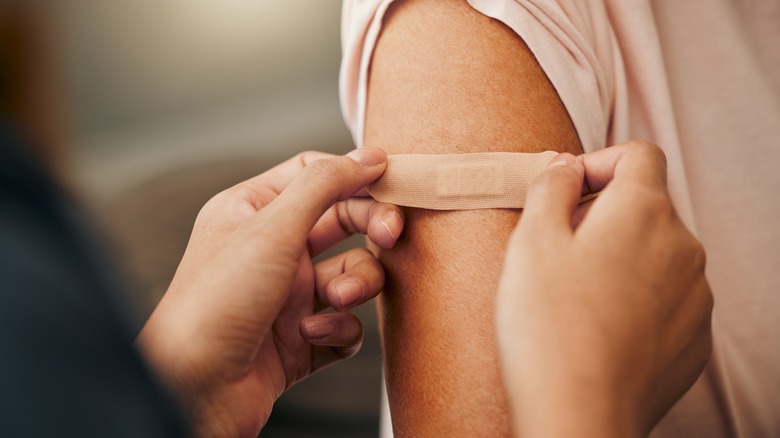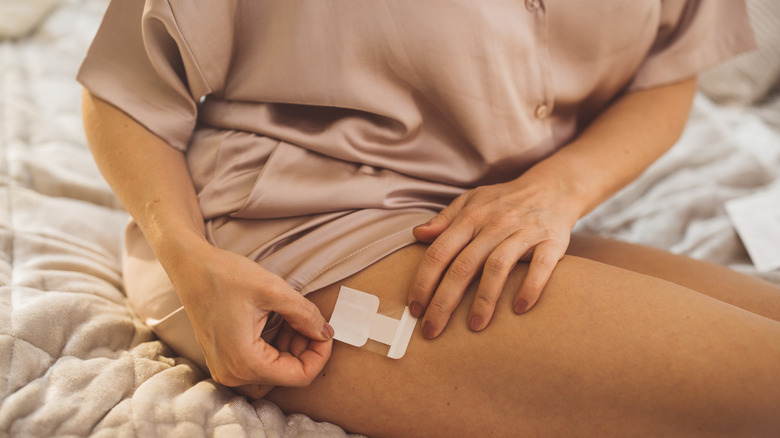How To Choose Which Type Of Band-Aid To Use
You're in the middle of slicing up a potato for dinner when you accidentally knick your finger. Typically, you grab a bandage from your cabinet and continue your day. But what if your wound isn't the size to fit your typical 1-inch by 3-inch bandage? Or what if, rather than slicing your finger, you burned yourself on the stove? Different injuries require different bandages to promote healing and keep infection at bay.
Bandage companies (including the Band-Aid brand) offer several varieties for large and small cuts, abrasions, and burns. Make sure you choose a bandage that is large enough to fit over the wound completely and is designed for the specific type of injury. If you select a bandage that's too small, you may leave the wound open for infection. It can also be excruciating when you remove a bandaid from a scabbed area, especially if the bandage is too small.
Just as important as the size of the wound is the location. Fingers and toes can be particularly difficult to bandage, requiring a dressing with a lot of flexibility. But you can learn to choose the perfect Band-Aid for everything from a sliced finger to road rash on your knee — and how to get the right fit on your knees, fingers, and toes.
Take the size of the wound into consideration
One of the first considerations of wound care is looking at the wound itself. You aren't going throw a large, bulky band-aid on a small wound on your finger, and it's going to take several bandage strips to cover a large scrape on your knee. Assess whether your injury is small enough for a 1-inch by 3-inch strip or needs something larger (like a 4-inch by 4-inch square). If you're between two sizes, use the larger size to ensure the adhesive doesn't irritate the cut or burn. You'll also want to fit the Band-Aid over the wound before removing the adhesive strips to ensure it's the right size.
Companies don't just create bandages of different sizes; they also consider your wound. Use a different dressing for an open cut than you would a burn by considering the best healing environment for the injury. Band-Aid offers hydrocolloid technology to prevent superficial cuts and scrapes from scabbing over, allowing wounds to heal faster and with less scarring. Wounds created in dirty environments can also benefit from medicated bandages. These have antibiotic ointment built right into them.
Selecting a bandage based on the size and type of your wound will help you promote faster healing and a secure fit in the long run. However, not all bandages will adhere perfectly to all body areas, so bandages for different locations must also be considered.
Choose the right Band-Aid for your location
Just like not all bandages are made to fit every wound, some bandages work better in some areas than others. The hardest to-fit places on the human body for a bandage are the joints like the fingers, toes, elbows, and knees. For example, getting a traditional Band-Aid to fit your finger can be hard without the viral finger Band-Aid hack and scissors. So, it would be best if you had something with some flex, like Tru-Stay and Skin-Flex bandages, designed specifically for areas that need to stretch and move.
Another consideration for getting the right fit and feel is whether your bandage will see a lot of moisture. Certain areas of your body are prone to sweat or see a lot of water action. For instance, you may wash your hands several times a day. Finding a waterproof bandage for a cut on your palm can save you from replacing it with every wash, or chancing that moisture and dirt may enter the area. Areas like your feet might be prone to sweating, so a waterproof bandage is beneficial. For skin that irritates easily, opt for a sensitive skin bandage, like a Gentle Care Band-Aid.
Life is full of cuts and scrapes, but covering them with a bandage can give your cut the best healing environment. Just make sure you find the right size, type, and flexibility to fit your wound (and prevent a trip to the doc for an infection).



